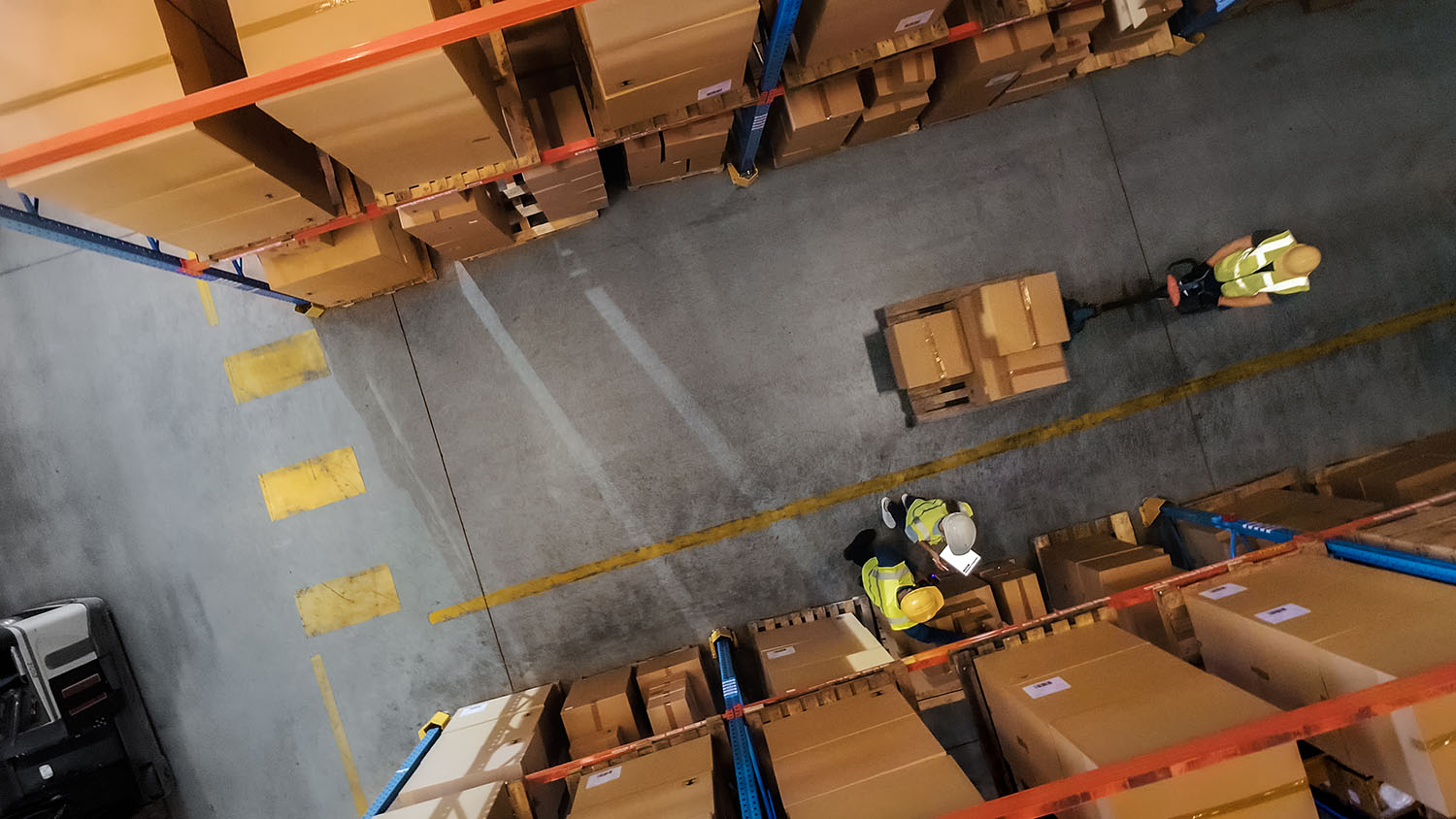For third-party logistics (3PL) providers, warehouse functions are the essential services they offer to clients, from receiving their goods all the way to handling their returns.
Warehouse functions encompass dozens of things they do to serve their logistics customers, from handling demand spikes and consolidating goods from multiple suppliers to adding value through services like labeling and kitting.
As supply chains grow more complex, 3PLs must constantly improve warehouse functions. Each function in its way plays a direct role in how much money the 3PL takes in, how much they spend, and how satisfied clients are with their service.
In this article, we’ll break down the key warehouse functions, explain why they matter, and explore how tools like warehouse management systems (WMS) help you meet modern customer demands.
10 Important Warehouse Functions for 3PLs
Here are 10 key warehouse functions for 3PLs:
1. Receiving
Receiving is accepting and processing incoming shipments from multiple suppliers on behalf of clients. This involves verifying goods’ accuracy, inspecting for damage, and updating inventory systems.
This first step sets the stage for how goods will be organized, stored, or moved within the warehouse. Errors at this stage, like missing items or incorrect SKUs, can disrupt your entire process.
Here’s how it usually works:
Workers unload goods from suppliers. They scan and match them against purchase orders or advanced shipping notices (ASNs) to confirm quantities. Once verified, items are prepared for storage or shipped directly, depending on the fulfillment strategy.
2. Storage
The storage or putaway process is when goods are stored in designated locations within the facility until order fulfillment. This involves categorizing items by product type, demand frequency, size, or client-specific rules.
Once determined, items are stored accurately in pallet racks, shelving, bins, or temperature-controlled zones.
Many 3PLs use different storage strategies, like random, dedicated, or class-based, that align with inventory movement and picking needs. These strategies help improve space utilization, reduce picker travel time, and maintain inventory levels.
3. Inventory Management
Inventory management refers to the ongoing process of tracking, updating, and reconciling stock levels within the warehouse. It gives clients visibility into available units, improves replenishment cycles, and avoids allocation errors.
You need to constantly track your inventory in real-time to meet client demands. Good inventory management allows your clients to accurately send stock to meet customer demand, plan marketing campaigns, and manage replenishment.
By knowing which items move quickly and which sit longer, you can also optimize storage placement, reduce picker travel time, and allocate space accurately.
4. Order Picking
Order picking is the process of locating and collecting the right products from storage to fulfill customer orders. It’s a labor-intensive task that alone accounts for nearly 70% of warehouse operating costs, making it one of the most important functions to optimize.
3PLs use several picking methods to manage different order volumes and shipping priorities. Some of them include:
- Wave picking: Items are picked in scheduled waves based on frequency or shipping deadlines.
- Zone picking: Each picker works within a specific area, and items are later grouped by order.
- Batch picking: Similar items for multiple orders are picked together, then sorted by order.
- Single-order picking: Items are picked for each order at a time.
3PLs often combine these methods based on product types and client needs. For example, a 3PL might use batch picking for bulk skincare orders during peak hours, then switch to single-order picking for express shipments closer to carrier cut-off times.
5. Packing
Packing is the final step in the order fulfillment process before goods leave the facility. You need to sort and pack the orders in a safe packaging and clearly branded labels.
Once items are picked, the workers verify the items, choose packaging that prevents damage, including documentation or inserts as required, and prepare the shipment for its final destination.
When handling different types of clients, each packing process may vary in complexity, speed, and customization.
6. Shipping
Shipping is the final step in warehouse functions, where packed orders are handed off to carriers for last-mile delivery.
After packing, orders are sorted by carrier or delivery method. The warehouse team scans, labels, and stages packages for pickup. It also coordinates with carriers based on service levels, destinations, and cut-off times.
Shipping directly affects delivery speed, customer satisfaction, and operational costs. Delays or mistakes at this stage, like incorrect labels, can lead to revenue loss.
7. Returns Handling
When a customer returns an order, 3PL receives and inspects its condition. Inventory records are updated, and it is decided whether to restock, quarantine, or discard the item. This process is known as returns handling or reverse logistics.
Returns handling is a warehouse function because it requires space, labor, and systems to inspect, sort, and store items. You need to have a well-documented returns process to protect the client’s brand reputation and recover resale value.
High return volumes are mostly common in e-commerce clients. Warehouses need to dedicate zones and workflows specifically for reverse logistics for this. It helps you process returns quickly, reduce inventory errors, and minimize waste.
8. Quality Control
Quality control in warehousing involves checking the condition, accuracy, and presentation of products at key stages. This warehouse function is usually done during receiving/picking, or before packing and shipping.
These checks are built into daily operations to catch issues early, like damaged goods, wrong SKUs, expired products, or missing items.
Quality control also helps you protect brand trust, reduce returns, and maintain service-level agreements. For example, a team might inspect incoming goods for visible damage, verify picked orders against packing slips, or double-check fragile items before sealing the box.
9. Cross-Docking
Cross-docking is the process of unloading incoming goods and routing them directly to outbound shipments without storing them. This function is used for time-sensitive or high-turnover products as it speeds up distribution, lowers storage costs, and reduces handling.
Cross-docking is very useful for retail replenishment, perishable goods, or promotional campaigns with tight delivery windows.
10. Value-Added Services (VAS)
Value-Added Services (VAS) are all the custom tasks 3PLs can perform beyond basic storage and shipping. This includes kitting, labeling, bundling, gift wrapping, or light assembly.
With VAS, 3PLs can customize orders to fit a specific client’s need to make the unboxing experience easy or support a seasonal marketing campaign without the client having to manage these steps themselves.
For example, a 3PL can assemble gift bundles for holiday sales, add branded inserts, and shrink-wrap each package before dispatch, saving the brand time and labor costs.
Why the Execution of Warehouse Functions Are Make or Break for 3PLs
From receiving to shipping, each warehouse function plays a role in how well goods move and how reliably client orders are fulfilled.
1. Direct Impact on SLAs and Client Retention
3PLs are judged based on their ability to meet service-level agreements, like on-time shipping, order accuracy, and returns handling.
These KPIs are directly tied to how well your warehouse functions. Over time, this consistency builds client confidence, reduces churn, and positions you as a reliable long-term growth partner.
2. Protects Service Margins
A well-structured warehouse function helps you extract more value from each labor hour and reduce costly delays that affect your profit margins.
For example, smart storage layouts improve space utilization, while optimizing picking paths reduces unnecessary movement across the floor.
3. Flexibility During Peak Demand
Well-structured warehouse functions allow you to handle high-volume periods like Black Friday or back-to-school season when demands spike overnight.
It also helps you scale up quickly, avoid fulfillment delays, and maintain quality despite high order volume.
4. Operational Visibility and Control
Warehouse functions help you create a more predictable and trackable workflow, from receiving to shipping. It is easier to monitor performance and troubleshoot problems when everything is mapped and consistently followed.
This level of control also supports better demand forecasting. With accurate inventory data and consistent order patterns, you can spot trends, plan for seasonal surges, and work with clients to adjust stock levels.
5. Better Client Satisfaction
With structured warehouse operations, you can adapt to different client needs. You can also offer value-added services like kitting, branded packaging, or custom labeling, which improve the end-customer experience.
This flexibility and attention to detail reflect your client’s brand. Accurate orders, on-time deliveries, and smooth returns build trust among clients and their customers.
Best Practices to Improve Your Warehouse Functions
Here’s how you can improve your warehouse functions:
1. Standardize Core Processes
Create clear SOPs (standard operating procedures) for receiving, putaway, picking, packing, and returns. When each team follows the same documented steps, it reduces room for error, speeds up onboarding, and improves coordination between departments.
2. Use Warehouse Management System
Adopt a cloud-based warehouse management system (WMS) to centralize and automate core warehouse functions like inventory tracking, order management, picking, packing, and shipping.
Instead of relying on spreadsheets, manual logs, or disconnected tools, WMS automates your entire fulfillment process. From designating storage locations to collecting real-time data, warehouse management software helps you achieve smarter planning and faster decision-making.
It also gives clients more confidence through live reporting, portal access, and smooth integration with their systems.
3. Implement Barcode or QR Code Scanning
Manual data entry during warehouse functions often leads to errors such as wrong SKUs, duplicate entries, or missed scans. Implement barcode or QR code scanning at every stage to capture real-time data and reduce human error.
Barcode scanning improves accuracy and speeds up receiving, picking, and packing tasks. For example, generating and validating barcodes for UCC-128 compliance helps meet retail partner requirements and streamline outbound logistics.
4. Apply Slotting Strategies Based on Demand
Organize inventory based on how often items are picked. Place fast-moving SKUs near packing stations or along picking paths, while storing slower-moving items further away.
This reduces travel time, speeds up picking, and improves labor performance, especially during peak periods or high-order-volume shifts.
Da Vinci’s WMS helps you adopt smart warehouse slotting techniques using algorithmic optimization.
The software analyzes your order history and demand patterns to predict high-demand items. It then designates storage locations based on this data.
6. Create a Dedicated Returns Handling Area
When you process returns alongside outbound operations, they clutter space, slow down workflows, and increase the risk of misplaced or unsorted inventory.
Set up a dedicated area in the warehouse specifically for handling returns. Include clear zones for inspection, sorting, restocking, and disposal. Keep this process separate from your outbound flow to avoid disruptions.
7. Track Order Fulfillment Rate and Other KPIs
Monitor key performance indicators (KPIs) like order fulfillment rate, pick accuracy, receiving time, and return processing speed. Use these warehouse KPIs to identify delays, set performance goals, and guide operational decisions.
Consistent KPI tracking can help you improve service quality, reduce costs, and make smarter decisions as you scale.
How Da Vinci WMS Improves Warehouse Functions
Da Vinci’s advanced WMS features are specifically designed for 3PLs to optimize their four most critical warehouse functions: receiving, inventory management, and order picking.
Da Vinci significantly enhances receiving accuracy through instant verification tools that match incoming shipments against purchase orders, reducing data entry errors and speeding up the putaway process.
For inventory management, the system’s real-time tracking capabilities and multi-client segregation ensure accurate stock levels and transparent reporting for each customer.
Da Vinci’s intelligent picking engine optimizes picker routes and supports multiple picking methods, speeding the function that consumes the bulk of warehouse operating costs.
Together, these improvements translate to faster order turnaround, reduced operating expenses, and the ability to scale services without proportional labor increases.
Book a free demo to learn more about how Da Vinci’s WMS helps you optimize your warehouse functions.



